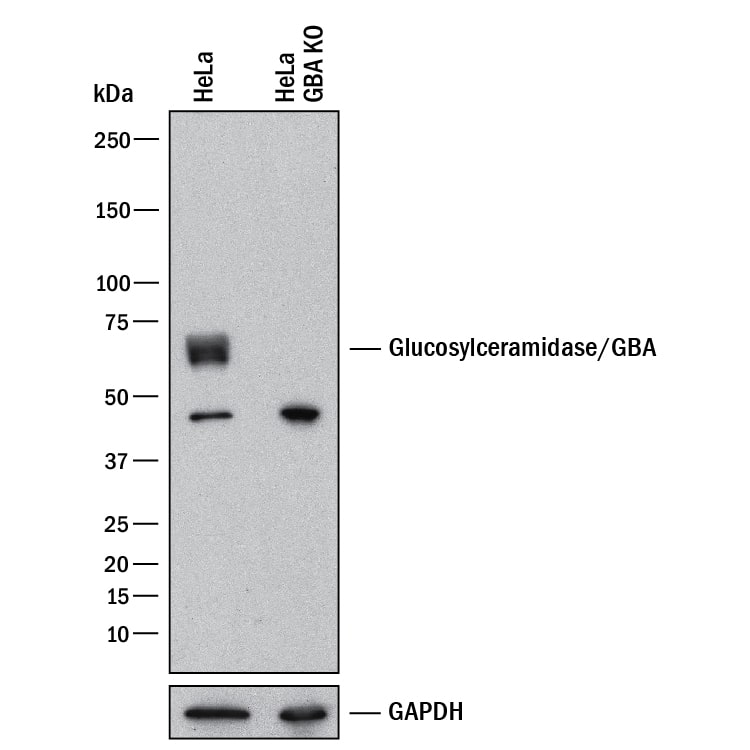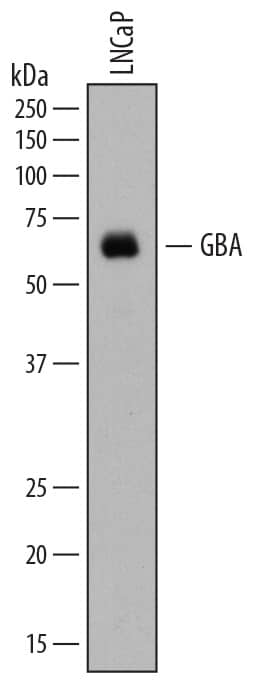Human Glucosylceramidase/GBA Antibody
R&D Systems, part of Bio-Techne | Catalog # MAB7410

Key Product Details
Validated by
Knockout/Knockdown
Species Reactivity
Validated:
Human
Cited:
Human
Applications
Validated:
Immunocytochemistry, Knockout Validated, Simple Western, Western Blot
Cited:
Immunohistochemistry, Western Blot
Label
Unconjugated
Antibody Source
Monoclonal Mouse IgG1 Clone # 812201
Product Specifications
Immunogen
Chinese hamster ovary cell line CHO-derived recombinant human Glucosylceramidase/GBA
Met1-Gln536
Accession # P04062
Met1-Gln536
Accession # P04062
Specificity
Detects human Glucosylceramidase/GBA in direct ELISAs. In direct ELISAs, no cross-reactivity with recombinant human Cytosolic beta‑Glucosidase/GBA3 is observed.
Clonality
Monoclonal
Host
Mouse
Isotype
IgG1
Scientific Data Images for Human Glucosylceramidase/GBA Antibody
Detection of Human Glucosylceramidase/GBA by Western Blot.
Western blot shows lysates of LNCaP human prostate cancer cell line. PVDF membrane was probed with 1 µg/mL of Mouse Anti-Human Glucosylceramidase/GBA Monoclonal Antibody (Catalog # MAB7410) followed by HRP-conjugated Anti-Mouse IgG Secondary Antibody (Catalog # HAF007). A specific band was detected for Glucosylceramidase/GBA at approximately 60 kDa (as indicated). This experiment was conducted under reducing conditions and using Immunoblot Buffer Group 1.Glucosylceramidase/GBA in HeLa Human Cell Line.
Glucosylceramidase/GBA was detected in immersion fixed HeLa human cervical epithelial carcinoma cell line using Mouse Anti-Human Glucosylceramidase/GBA Monoclonal Antibody (Catalog # MAB7410) at 15 µg/mL for 3 hours at room temperature. Cells were stained using the Northern-Lights™ 557-conjugated Anti-Mouse IgG Secondary Antibody (red; Catalog # NL007) and counterstained with DAPI (blue). Specific staining was localized to lysosomes. View our protocol for Fluorescent ICC Staining of Cells on Coverslips.Detection of Human Glucosylceramidase/GBA by Simple WesternTM.
Simple Western lane view shows lysates of LNCaP human prostate cancer cell line and HEK293T human embryonic kidney cell line, loaded at 0.2 mg/mL. A specific band was detected for Glucosylceramidase/GBA at approximately 77 kDa (as indicated) using 10 µg/mL of Mouse Anti-Human Glucosylceramidase/GBA Monoclonal Antibody (Catalog # MAB7410). This experiment was conducted under reducing conditions and using the 12-230 kDa separation system.Applications for Human Glucosylceramidase/GBA Antibody
Application
Recommended Usage
Immunocytochemistry
8-25 µg/mL
Sample: Immersion fixed HeLa human cervical epithelial carcinoma cell line
Sample: Immersion fixed HeLa human cervical epithelial carcinoma cell line
Knockout Validated
Glucosylceramidase/GBA
is specifically detected in HeLa human cervical epithelial carcinoma parental cell line but is not detectable in
Glucosylceramidase/GBA knockout HeLa human cervical epithelial carcinoma cell line.
Simple Western
10 µg/mL
Sample: LNCaP human prostate cancer cell line and HEK293T human embryonic kidney cell line
Sample: LNCaP human prostate cancer cell line and HEK293T human embryonic kidney cell line
Western Blot
1 µg/mL
Sample: LNCaP human prostate cancer cell line
Sample: LNCaP human prostate cancer cell line
Formulation, Preparation, and Storage
Purification
Protein A or G purified from hybridoma culture supernatant
Reconstitution
Sterile PBS to a final concentration of 0.5 mg/mL. For liquid material, refer to CoA for concentration.
Formulation
Lyophilized from a 0.2 μm filtered solution in PBS with Trehalose. *Small pack size (SP) is supplied either lyophilized or as a 0.2 µm filtered solution in PBS.
Shipping
Lyophilized product is shipped at ambient temperature. Liquid small pack size (-SP) is shipped with polar packs. Upon receipt, store immediately at the temperature recommended below.
Stability & Storage
Use a manual defrost freezer and avoid repeated freeze-thaw cycles.
- 12 months from date of receipt, -20 to -70 °C as supplied.
- 1 month, 2 to 8 °C under sterile conditions after reconstitution.
- 6 months, -20 to -70 °C under sterile conditions after reconstitution.
Background: Glucosylceramidase/GBA
References
- Sorge, J. et al. (1985) Proc. Natl. Acad. Sci. USA 82:7289.
- Ginns, E. I. et al. (1984) Biochem. Biophyl. Res. Commun. 123:574.
- Horowitz, M. et al. (1989) Genomics 4:87.
- Grace, M.E. et al. (1994) J. Biol. Chem. 269:2283.
- Bruhn, h. (2005) Biochem. J. 389:249.
- Liou, B. et al. (2006) J. Biol. Chem. 281:4242.
- Grabowski, G.A. (2008). Lancet 372: 1263–1271.
- Zheng, W. et al. (2007) Proc. Natl. Acad. Sci. USA 104:13192.
- Beutler, E. and Gelbart, T. (1996) Hum. Mutat. 8:207.
Alternate Names
Alglucerase, GBA, GBA1, Imiglucerase
Gene Symbol
GBA
UniProt
Additional Glucosylceramidase/GBA Products
Product Documents for Human Glucosylceramidase/GBA Antibody
Product Specific Notices for Human Glucosylceramidase/GBA Antibody
For research use only
